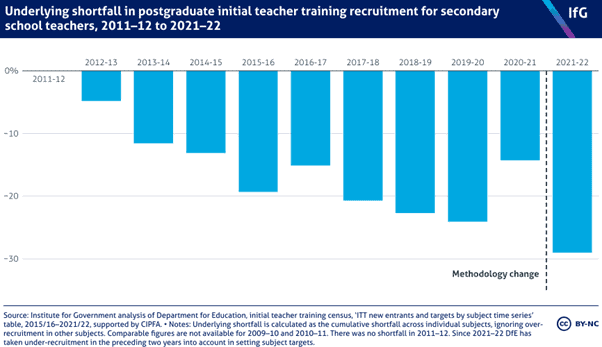[ad_1]
The actuality that educational institutions are sensation the pressure won’t appear as a surprise to quite a few individuals. But pretty how a great deal of a pressure?
That’s the question we respond to in our new effectiveness tracker report, developed with CIPFA.
It assesses the state of 9 community providers including universities, looking at needs on the service, the funding and staffing picture, and the impression that Covid has experienced.
On staffing, we entered the pandemic getting had recruitment and retention problems for a lot of the past decade.
Instructor figures were being increasing, but there had been a variety of subjects – physics, structure and know-how, languages – where shortages had been the two significant and persistent.
Recruitment improved at the start out of the pandemic (as did retention) – but this was only non permanent.
We work out what we refer to as the ‘underlying shortfall’ in secondary publish-graduate trainee numbers – properly, the full hole in between quantities recruited and the government’s matter-amount targets, disregarding around-recruitment in other subjects (for the reason that a PE teacher isn’t the same as a physics trainer).
This strike 29 per cent in 2021-22 – that is, recruitment targets had been missed by just about a third.

The federal government has set much more cash into colleges in both the 2019 expending spherical and the 2021 paying evaluation.
And, even though this will not be real of all educational institutions, DfE figures propose that, on regular, the finances of educational facilities enhanced in the very first year of the pandemic.
Less universities and academy trusts experienced detrimental financial reserves, which the DfE places down to educational facilities expending significantly less on source instructors, studying methods and test charges, between other regions.
‘Schools are owning to offer with soaring inflation’
But as with other community companies, as effectively as companies and people today, educational institutions are now getting to offer with soaring inflation.
Extra to that is a pay settlement that presents a challenge to university budgets – even though representing a authentic-terms spend cut for lecturers.
Schools encounter this challenge whilst nevertheless seeking to make up for shed learning in the course of Covid.
This summer’s critical stage 2 assessments have supplied confirmation of the scale of this finding out loss at key amount, with the share of pupils at the expected standard in reading, producing and maths falling from 65 per cent in 2019 to 59 for every cent this calendar year.
Apparently the nationwide reference test, taken by a sample of year 11 college students, implies a much more mixed image, with a statistically substantial fall in maths benefits among 2020 and 2022, but no substantial drop in English outcomes.
But absent from these headline final results, several would deny that the pandemic has had a substantial influence on young people’s efforts to discover about the past two and a fifty percent many years.
With the disruption to in-man or woman educating found in 2020 and 2021 this was constantly heading to be the scenario, and is the purpose the then-education and learning restoration commissioner, Kevan Collins, called for around £15 billion of capture-up support.
To date, catch-up funding of £4.9bn has been dedicated by the DfE.
‘We really do not know if tutoring is having the meant effect’
Since the emphasis of the Nationwide Tutoring Programme has moved from a centralised method to one in which universities recruit their personal tutors the scheme has started out reaching large figures of pupils.
We never have figures for the entirety of the 2021-22 academic year, but the programme was almost certainly heading to get to 2 million system starts for the yr.
But all we really know is that pupils are starting courses – not no matter if they’re acquiring the intended influence.
An analysis of the NTP’s initial calendar year, 2020-21, however has not been revealed, this means we’re flying blind in phrases of understanding whether or not it’s doing work.
In general, then, this leads us to conclude in performance tracker that though educational facilities are weathering the activities that have come their way in the previous handful of decades improved than some other community providers, the conditions aren’t in spot to get things again to pre-pandemic degrees by 2025.
Principally funding: with a £10 billion hole among what Kevan Collins explained would be required for catch-up and what the Department for Education and learning has built obtainable, we’re not likely to get back to pre-pandemic benchmarks as rapidly as we’d all like.
[ad_2]
Meet Our Successful Graduates: Learn how our courses have propelled graduates into rewarding
careers. Explore their success stories here!
Discover More About Your Future: Interested in advancing your teaching career? Explore our
IPGCE, MA, and QTS courses today!

Explore Our Courses: Ready to take the next
step in your education journey? View our
comprehensive course offerings now!

